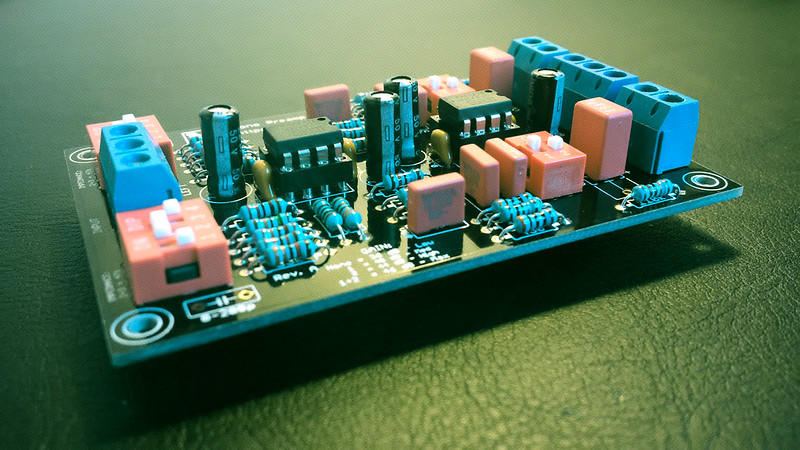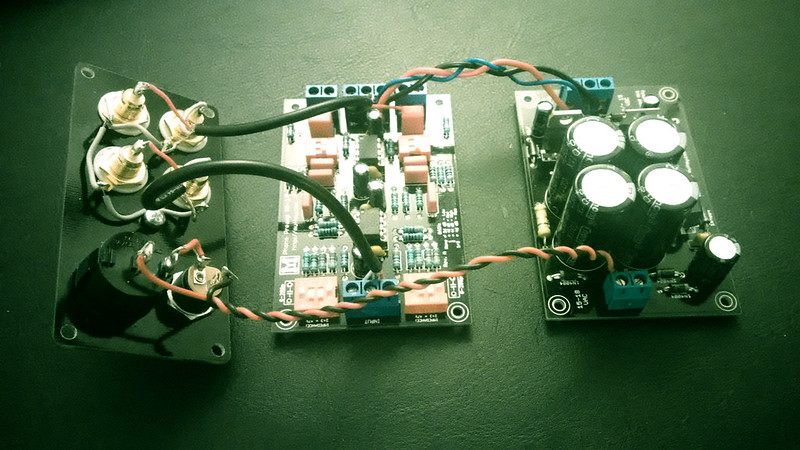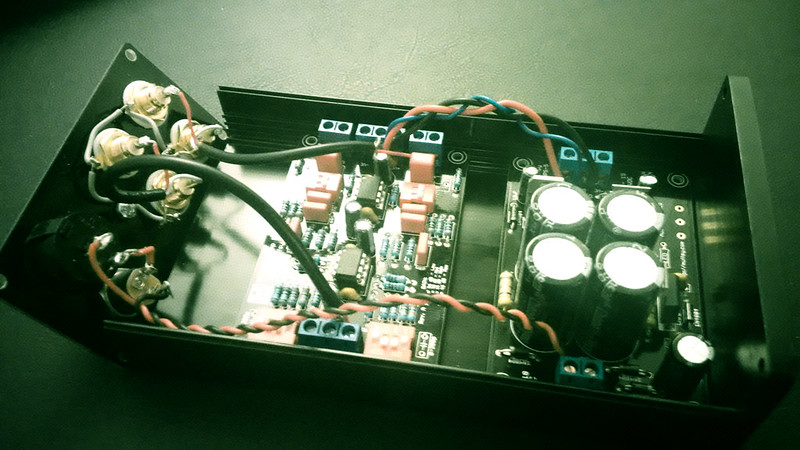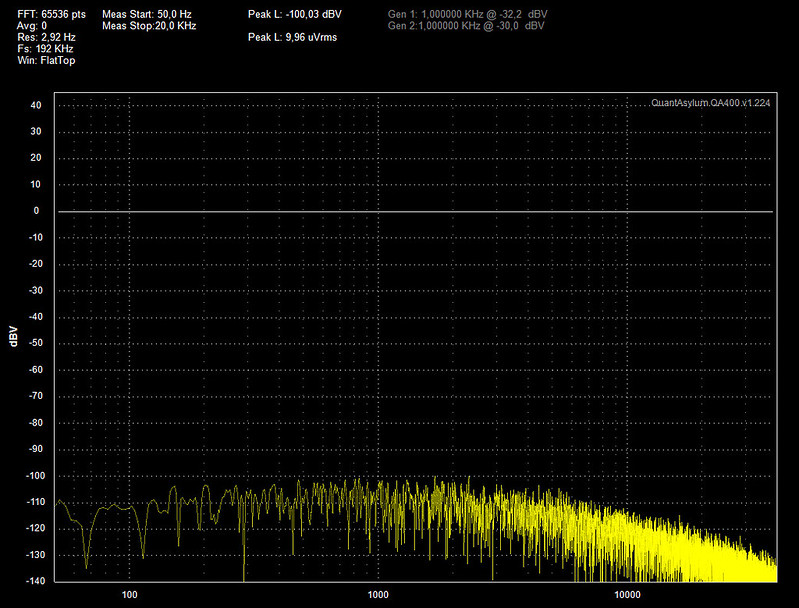Here's a few pics of the phono stage.
Phono stage, assembled:

Power supply, assembled:

All bits and pieces connected:

Phono stage mounted in a B0905 enclosure:

Phono stage, assembled:

Power supply, assembled:

All bits and pieces connected:

Phono stage mounted in a B0905 enclosure:

Skrodahl, I am going to refloat this post, because I built the phono stage Muffsy and really surprised me performance.
As you may have noticed, apart from my work and profession, I am a fan audio enthusiast.
I have also discovered that certain components of the audio chain built by our own hand or from kits, have better performance than expensive components purchased from renowned brands.
Thus, in my case between several buildings I have made 4 phono stages from totally made by my own hands to the assembly kits.
Among them I have assembled kit Muffsy.
I have an obligation to say that all of them are excellent phono stages that surpass known commercial stages, but Muffsy has really exceeded all parameters normally used to refer to phono stages: sound light, airy; clean, powerful bass; wide and deep sound stage; breathtakingly clear details; treble present but not strenuous; clear and real voices; AWESOME and dynamics.
Not really why the difference, as in other buildings also have used high quality components.
Congratulations.
In the next post I upload photos.
Add: completely silent even with the volume at maximum.
PD:I think this post should move to "analog source".
As you may have noticed, apart from my work and profession, I am a fan audio enthusiast.
I have also discovered that certain components of the audio chain built by our own hand or from kits, have better performance than expensive components purchased from renowned brands.
Thus, in my case between several buildings I have made 4 phono stages from totally made by my own hands to the assembly kits.
Among them I have assembled kit Muffsy.
I have an obligation to say that all of them are excellent phono stages that surpass known commercial stages, but Muffsy has really exceeded all parameters normally used to refer to phono stages: sound light, airy; clean, powerful bass; wide and deep sound stage; breathtakingly clear details; treble present but not strenuous; clear and real voices; AWESOME and dynamics.
Not really why the difference, as in other buildings also have used high quality components.
Congratulations.
In the next post I upload photos.
Add: completely silent even with the volume at maximum.
PD:I think this post should move to "analog source".
Last edited:
Re - Muffsy Phono Stage
I looked at the specs, & saw SNR = 112.83db Even with inputs shorted on a non passive RIAA, ie Active stage, i have Never seen such a High figure !
How can this be ?
I looked at the specs, & saw SNR = 112.83db Even with inputs shorted on a non passive RIAA, ie Active stage, i have Never seen such a High figure !
How can this be ?
I can not tell if it really is. I have no instruments to measure it.
What I can say is that of all phono stages I've had and I've built is the most silent.
If you turn up the volume on your amplifier, the maximum only a slight sssss is heard when approaching the ear to the speaker.
And I add, of all phono stages that I have and have had, even recognized brand, it is the best performance has.
Of course I've never heard stages of thousands of dollars, that any, but I've learned that you can play an LP in very good shape with DIY stages.
Greetings, José.
What I can say is that of all phono stages I've had and I've built is the most silent.
If you turn up the volume on your amplifier, the maximum only a slight sssss is heard when approaching the ear to the speaker.
And I add, of all phono stages that I have and have had, even recognized brand, it is the best performance has.
Of course I've never heard stages of thousands of dollars, that any, but I've learned that you can play an LP in very good shape with DIY stages.
Greetings, José.
@ ALPUY
Well i'm pleased you're happy with it ! I wasn't trying to say it's crap etc, just wondering how they got such a Large SNR ?
Also no overload specs were mentioned ? I expect they are not that high ?
Well i'm pleased you're happy with it ! I wasn't trying to say it's crap etc, just wondering how they got such a Large SNR ?
Also no overload specs were mentioned ? I expect they are not that high ?
zero D, I can not say whether the technical characteristics of Muffsy are those published or not. If I can say that all I've heard is built and which has better performance. It is my opinion. If you want to know about how they have obtained measurement data, there is a Muffsy page, and you can ask Skrodahl that is what has made these measurements. Greetings and really recommend it.
Hi,
The measurements are done using a QuantAsylum QA400 audio analyzer. (https://www.quantasylum.com/content/Products/QA400.aspx)
To get the SNR, you adjust the input signal until you get an output signal with 1% distortion. Then you short the inputs and measure the distortion. The SNR is the ratio between those two figures. (AP High Performance Audio Analyzer & Audio Test Instruments : Service & Support)
I could not get 1% distortion (without clipping the signal), so I set the reference output to 0 dBV. Inputs shorted, bandwidth 20 Hz - 20 kHz, the noise is 112.83 dB below 0 dBV. 0 dBV/1 V rms is what the Muffsy produces with a 5 mV @1 kHz cartridge at 46 dB gain. At this level, the THD+N is measured to 0.01013%. All measurements are A-weighted btw.
Here's how the Muffsy performs with an input signal that gives 1 V rms / 0 dBV output (i.e. inputs not shorted):

As for the headroom, this is limited by the PSU and the first op amp gain stage. According to the RIAA curve, a 20 kHz signal is ~20 dB higher than the 1 kHz signal. In voltage, that's 10X. 5 mV at 1 kHz is 50 mV at 20 kHz.
The PSU delivers 30 V rail-to-rail (+/- 15 V), which is 10.6 V rms. The op amps can of course not swing all that way, so let's use 7 V rms instead which gives us a useful rail-to-rail voltage of 20 V. To hit that limit, you need 200 mV at 20 kHz, which is 20 mV at 1 kHz. For a cartridge that delivers 5 mV at 1 kHz, that's a smidge above 12 dB headroom.
That's the limitation of the first gain stage. After that, everything is equalized to the level of the 1 kHz signal. With 20 mV/1kHz in, you get 3.9 volts at the output using the highest gain setting of 46 dB.
The measurements are done using a QuantAsylum QA400 audio analyzer. (https://www.quantasylum.com/content/Products/QA400.aspx)
To get the SNR, you adjust the input signal until you get an output signal with 1% distortion. Then you short the inputs and measure the distortion. The SNR is the ratio between those two figures. (AP High Performance Audio Analyzer & Audio Test Instruments : Service & Support)
I could not get 1% distortion (without clipping the signal), so I set the reference output to 0 dBV. Inputs shorted, bandwidth 20 Hz - 20 kHz, the noise is 112.83 dB below 0 dBV. 0 dBV/1 V rms is what the Muffsy produces with a 5 mV @1 kHz cartridge at 46 dB gain. At this level, the THD+N is measured to 0.01013%. All measurements are A-weighted btw.
Here's how the Muffsy performs with an input signal that gives 1 V rms / 0 dBV output (i.e. inputs not shorted):

As for the headroom, this is limited by the PSU and the first op amp gain stage. According to the RIAA curve, a 20 kHz signal is ~20 dB higher than the 1 kHz signal. In voltage, that's 10X. 5 mV at 1 kHz is 50 mV at 20 kHz.
The PSU delivers 30 V rail-to-rail (+/- 15 V), which is 10.6 V rms. The op amps can of course not swing all that way, so let's use 7 V rms instead which gives us a useful rail-to-rail voltage of 20 V. To hit that limit, you need 200 mV at 20 kHz, which is 20 mV at 1 kHz. For a cartridge that delivers 5 mV at 1 kHz, that's a smidge above 12 dB headroom.
That's the limitation of the first gain stage. After that, everything is equalized to the level of the 1 kHz signal. With 20 mV/1kHz in, you get 3.9 volts at the output using the highest gain setting of 46 dB.
Thank you very much for such a clear explanation. I always said, "dying and learning." Although my profession has nothing to do with electronics, I was always as it mainly hobbyist DIY audio.
Greetings Jose.
Greetings Jose.
@ skrodahl
Hi, & Thanx for posting 🙂
Again, i'm not saying it doesn't sound nice etc, just asking 😉
In the circuit diagrams i saw, the PSU = +/- 12V so the headroom would be even less than 12db with +/- 12V. With some material, and/or cartridges, this might not be enough !
I not aware of seeing any testing for SNR like that before, or such high figures ? All the SNR specs i've seen over the years, on both DIY & commercial RIAA preamps, are usually around 72db for moving iron carts. So they obviously measure differently. In which case, how would this design compare if SNR was measured the way the others are ?
That QA400 was very good value. The QA401 not as good, but it seems like a decent piece of gear though.
Hi, & Thanx for posting 🙂
Again, i'm not saying it doesn't sound nice etc, just asking 😉
In the circuit diagrams i saw, the PSU = +/- 12V so the headroom would be even less than 12db with +/- 12V. With some material, and/or cartridges, this might not be enough !
I not aware of seeing any testing for SNR like that before, or such high figures ? All the SNR specs i've seen over the years, on both DIY & commercial RIAA preamps, are usually around 72db for moving iron carts. So they obviously measure differently. In which case, how would this design compare if SNR was measured the way the others are ?
That QA400 was very good value. The QA401 not as good, but it seems like a decent piece of gear though.
Real life numbers are, as you see from the measurement graph, not as good as with shorted inputs. I did the measurements over and over again, as it's close to what the QA400 can handle. The SNR result is an average of 10-15 measurements because the decimals fluctuate a bit at those levels, and I must admit that I did not question the results.
You see that I stated the SNR in dBV, because it's relative to 0 dBV. you could get 3.9 volts output from this circuit, which would have added another ~11 dBr to these numbers. It sounds quite dramatic, so I think doing some more measurements would be in order. You can see from this thread that I have had a lot of help getting measurements right. It's really hard to get correct numbers at these low levels.
EDIT: This also depends on the input and the gain. A cartridge giving 3.5 mV/1 kHz and 36 dB gain would send the SNR south of 100 dBr.
A PSU of +/- 12 volts has 8.5 volts rms rail-to-rail, which should be sufficient to provide those 7 volts rms required for the headroom I stated. The reason I said +/- 15 volts is that I use this PSU: https://hackaday.io/project/5676-muffsy-hifi-dual-power-supply
200 mV input (at all frequencies, this being a passive RIAA) is needed to overload the phono stage. I could also do a dirty trick and say that that's the overload spec and "forget" that I only stated it at 1 kHz. That would give a comfortable headroom of 32 dB. It's only usable relative to the highest frequencies. At 20 mV/1 kHz you can expect 200 mV/20 kHz, so 12 dB is a number I can stand by.
Overloading at 20 mV/1 kHz is quite low compared to many other (active RIAA) phono stages. It can be improved quite a bit, up to 70 mV by changing the gain in the first stage to 20 dB. That would require much more gain in the second stage and give more noise, so it's a compromise that I'm happy with.
You see that I stated the SNR in dBV, because it's relative to 0 dBV. you could get 3.9 volts output from this circuit, which would have added another ~11 dBr to these numbers. It sounds quite dramatic, so I think doing some more measurements would be in order. You can see from this thread that I have had a lot of help getting measurements right. It's really hard to get correct numbers at these low levels.
EDIT: This also depends on the input and the gain. A cartridge giving 3.5 mV/1 kHz and 36 dB gain would send the SNR south of 100 dBr.
A PSU of +/- 12 volts has 8.5 volts rms rail-to-rail, which should be sufficient to provide those 7 volts rms required for the headroom I stated. The reason I said +/- 15 volts is that I use this PSU: https://hackaday.io/project/5676-muffsy-hifi-dual-power-supply
200 mV input (at all frequencies, this being a passive RIAA) is needed to overload the phono stage. I could also do a dirty trick and say that that's the overload spec and "forget" that I only stated it at 1 kHz. That would give a comfortable headroom of 32 dB. It's only usable relative to the highest frequencies. At 20 mV/1 kHz you can expect 200 mV/20 kHz, so 12 dB is a number I can stand by.
Overloading at 20 mV/1 kHz is quite low compared to many other (active RIAA) phono stages. It can be improved quite a bit, up to 70 mV by changing the gain in the first stage to 20 dB. That would require much more gain in the second stage and give more noise, so it's a compromise that I'm happy with.
Last edited:
That QA400 was very good value. The QA401 not as good, but it seems like a decent piece of gear though.
I wasn't aware that there's a new version available. It costs quite a bit more, so I guess I'll stick with the QA400 for now.
Skrodahl, you show a -112.83dB SNR figure?
Looking at the graph in your posting #105, I wonder how you got this.
Without an anti RIAA network, noise would have followed the RIAA curve.
And with an anti RIAA curve, noise would have been flat.
None of both is the case, but I guess that you have used an anti RIAA network with a not so good response, and/or with some form of high frequency weighting applied
With an input op-amp producing 8nV/rtHz and 46dB gain, I would expect the average noise lying at ca. -116dB and not at -106dB (or at -105dB for the used 1,46 Hz filter bandwidth in your graph).
For an MM RIAA preamp, it is correct to specify SNR at 5mV input signal, in your case resulting in 1V rms output signal (46dB gain).
On the other hand, an unweighted SNR figure has hardly any meaning as discussed in Linear Audio Vol6, in the article "Riaa Revisited".
In the same article a rule of thumb has been given to calcultate the A-Weighted noise within a few dB accurate for a Riaa amp based on the base-noise of the input amp.
With 8nV/rtHz for the OPA2134, and 46dB gain@1Khz, this rule gives:
8*200*0.061=97.6 uV.
With 1V rms out this is -80dB SNR A-Weighted ref. 5mV input with the input shorted. Not bad at all, but not even close to -122.8dB unweighted.
Hans
Looking at the graph in your posting #105, I wonder how you got this.
Without an anti RIAA network, noise would have followed the RIAA curve.
And with an anti RIAA curve, noise would have been flat.
None of both is the case, but I guess that you have used an anti RIAA network with a not so good response, and/or with some form of high frequency weighting applied
With an input op-amp producing 8nV/rtHz and 46dB gain, I would expect the average noise lying at ca. -116dB and not at -106dB (or at -105dB for the used 1,46 Hz filter bandwidth in your graph).
For an MM RIAA preamp, it is correct to specify SNR at 5mV input signal, in your case resulting in 1V rms output signal (46dB gain).
On the other hand, an unweighted SNR figure has hardly any meaning as discussed in Linear Audio Vol6, in the article "Riaa Revisited".
In the same article a rule of thumb has been given to calcultate the A-Weighted noise within a few dB accurate for a Riaa amp based on the base-noise of the input amp.
With 8nV/rtHz for the OPA2134, and 46dB gain@1Khz, this rule gives:
8*200*0.061=97.6 uV.
With 1V rms out this is -80dB SNR A-Weighted ref. 5mV input with the input shorted. Not bad at all, but not even close to -122.8dB unweighted.
Hans
For an MM RIAA preamp, it is correct to specify SNR at 5mV input signal, in your case resulting in 1V rms output signal (46dB gain).
On the other hand, an unweighted SNR figure has hardly any meaning as discussed in Linear Audio Vol6, in the article "Riaa Revisited".
In the same article a rule of thumb has been given to calcultate the A-Weighted noise within a few dB accurate for a Riaa amp based on the base-noise of the input amp.
With 8nV/rtHz for the OPA2134, and 46dB gain@1Khz, this rule gives:
8*200*0.061=97.6 uV.
With 1V rms out this is -80dB SNR A-Weighted ref. 5mV input with the input shorted. Not bad at all, but not even close to -122.8dB unweighted.
Hans
Hi Hans, and thanks for lending a hand.
The SNR is normally a level where the distortion is 1%, relative to the noise level with the inputs shorted. I shorted the inputs, found the noise level using the QA400 and called that the SNR. That's obviously not over the whole frequency range, so the graph that I posted in an earlier post is much closer to the truth.
The measurements were all A-weighted btw.
That's obviously not over the whole frequency range...
Perhaps I was too quick there? The measurements with shorted input was also 10-20.000 Hz, like the posted screenshot. Hmmm, I should really measure some more...
Perhaps I was too quick there? The measurements with shorted input was also 10-20.000 Hz, like the posted screenshot. Hmmm, I should really measure some more...
If your graph has been A-Weighted, the flat low frequency part below 100Hz looks suspiciously high, but the -79,9dB that is mentioned above in the graph comes very close indeed to the -80dB-A from the calculation in my earlier posting.
But 112.83dB -79.9dB = 32.93dB more SNR would mean 32.93dB more signal with the same noise, or an impossible 44,3Volt output instead of 1Vrms!
But again, SNR for MM Riaa preamps are specified at 5mV input and for MC Riaa preamps at 0.5mv input signal.
Hans
Last edited:
But 112.83dB -79.9dB = 32.93dB more SNR would mean 32.93dB more signal with the same noise, or an impossible 44,3Volt output instead of 1Vrms!
Hans
Yup, I definitely need to do some more measurements. I'll post them here when I have the time.
Thanks again for your help Hans.
Hi Hans,
Sorry it's taken so long to assemble a new phono stage. Life happens, and these things get postponed.
EDIT: The graph is with Flat Top windowing, and it is A-weighted
Here's the SNR measurement. The input is shorted, the output is fed into the QA400 at 24-bit/192 Ksps. I got -110.3 dBV this time around:

Here's what the QuantAsylum QA400 shows with no input at all:

Sorry it's taken so long to assemble a new phono stage. Life happens, and these things get postponed.
EDIT: The graph is with Flat Top windowing, and it is A-weighted
Here's the SNR measurement. The input is shorted, the output is fed into the QA400 at 24-bit/192 Ksps. I got -110.3 dBV this time around:

Here's what the QuantAsylum QA400 shows with no input at all:

Last edited:
Well, I had the gain set to 36 dB. Here's on 46 dB:

No change in the schematics, other than the 2k2 resistors at the input changed to 300R.
EDIT: Sorry, old picture. The 430R resistors in the variable gain (gain stage #2) are also 300R.

Here's the same measurement, unweighted:


No change in the schematics, other than the 2k2 resistors at the input changed to 300R.
EDIT: Sorry, old picture. The 430R resistors in the variable gain (gain stage #2) are also 300R.

Here's the same measurement, unweighted:

Last edited:
- Status
- Not open for further replies.
- Home
- Source & Line
- Analogue Source
- AK phonostage